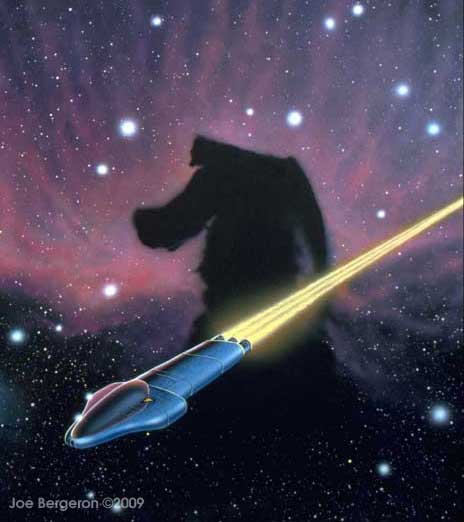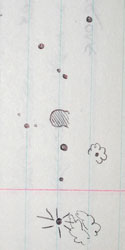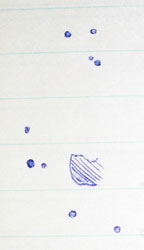One of most sought-after, and most notorious, objects in the sky is the Horsehead Nebula,
otherwise known as Barnard 33 in Orion. Viewing this small dark patch superimposed over the faint
streak of the nebula IC 434 is considered a rite of passage among deep sky observers. While most
agree it isn't an easy sighting, many disagree about the minimum equipment and conditions needed to
see it at all. Some observers take a little too much pride in their own experience and capabilities.
They verge on calling those who have seen the Horsehead with smaller equipment liars or delusional.
The mistake these people make, of course, is to assume that their abilities set the standard for all others.
People possess a wide range of ability in all areas of strength, intelligence, agility, dexterity, and so forth.
It makes no sense to suppose that a similar range doesn't exist in our eyes and even in the ability of
our brains to process and interpret visual information.
Assuming that others can't possibly see more than you do is arrogant and risky, regardless of your
level of experience. For example, Sue French often shows me things (incredibly obscure things) in her
smallish telescopes which are initially invisible to me. Sometimes, with the help of her careful
explanations of exactly what I'm looking for and where, I am able to discern these phantoms.
Sometimes I'm not. Do I then suppose that Sue is out of her mind? Nope. I suppose she can do
some things I can't, just as I can do some things others can't.
I have gone back over my notes to summarize my history of observing the Horsehead. I hope it will
assist and encourage others to seek it out for themselves.

Part of dust jacket art for Doubleday edition of Isaac Asimov's The Stars, Like Dust.
Magenta color and spaceship are rarely seen in amateur telescopes.
8-inch f/5 reflector, Fearrington, North Carolina
"I looked with 39x. The bifurcate nebula (NGC 2024) and the little reflection patch (NGC 2023) were both easy. I also saw the faintest nothing of a glow of light south of Zeta, and in it the most inconspicuous patch of darkness imaginable, shapeless or maybe squarish at best. On a scrap of paper I drew what I saw:

The Horsehead Nebula! Perfect match with photos. Gosh!"
Fearrington was a new housing development a few miles south of Chapel Hill, not a terrible site, but not the darkest or clearest either (I'm sure it's much worse now). This was my first view of the nebula after many attempts. I had no filter at the time.
8-inch f/5 reflector, Big Bend National Park, Texas
"Horsehead: this was a snap both with and without the UHC filter at 42x. The dark wedge of the nebula was unmistakable!"
My nights at Big Bend were among the finest I've ever had.
6" f/8 refractor, Canebrake, California
"Horsehead-Invisible at 50x, but not too hard at 38x (with UHC, of course). I sketched the field:

The Horsehead is a good sized, shapeless blankness on a nebulous field so faint as to be nearly invisible. NGC 2024 was easy with and without the filter."
This is a very fine dark site. NGC 2024 is a good warmup object for the Horsehead. If it's not both easy and detailed, you can forget about the Horsehead. Just don't mistake it for the Horsehead itself.
14.5" f/5.5 reflector, Winter Star Party, Florida
"I found this fairly conspicuous as a vague, dark blob with the UHC, but no one else who tried it met with any success."
See? Some people can see certain things, while others can't. WSP is better known for its seeing than its dark skies, but it isn't (yet) a bad site either.
14.5" f/5.5 reflector, Winter Star Party, Florida
"Horsehead was pretty easy at 58X with the Panoptic 35mm and my new UHC filter. Here's my sketch:

155mm f/9 refractor, Winter Star Party, Florida
Horsehead-Saw it with some difficulty at 65x with UHC-it got easier as I studied it. I sketched the field as usual. Later I used Bob Summerfield's large Dob to see it with H-Beta and Daystar Broadband filters. The H-Beta gave a more contrasty view, but it still didn't exactly jump out at you.
9.25" A-P Mak-Newt, Winter Star Party, Florida
"I found the Horsehead, despite Roland's protestations of its impossibility."
155mm refractor, Winter Star Party, Florida
"Horsehead-had as good or better a view of this as I ever have, using 65x and UHC. The swath of nebulosity was distinct, and the head itself almost easy."
36" "Yard Scope" reflector
"Had a fantastic view with an H-Beta filter. By far the best I've seen, bright and clear, an unambiguous direct vision object."
10" f/6 reflector, Winter Star Party, Florida
"Not the best night, but we still saw some decent stuff. Horsehead-First had a clear sighting in Sue French's 4" Traveler, then we found it obvious in the 10" with the 22mm Panoptic. Using Sue's H-Beta filter made it so clear than even Alan saw it. Later we looked with an 18" Obsession, which made it look bigger, but not really brighter."
10" f/6 reflector, Canebrake, California
"Horsehead-I swung over to Zeta Orionis, noted the bright Flame Nebula, then then dropped down a bit, spotting the Horsehead almost immediately, a darkness in a band of faint nebulosity."
92mm refractor, Canebrake, California
"I saw the Flame Nebula readily, and spotted the little reflection nebula NGC 2023, and even glimpsed the strip in which the Horsehead lies, but not the Horse itself."
So, I've failed to see the Horsehead with the little Stowaway. Clearly, that means no one could do it!
I'm kidding.





